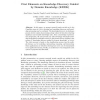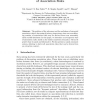129
Voted
CLA
2006
15 years 2 months ago
2006
The paper presents additional results on factorization by similarity of fuzzy concept lattices. A fuzzy concept lattice is a hierarchically ordered collection of clusters extracted...
100
click to vote
CLA
2006
15 years 2 months ago
2006
We present graded extension of the algorithm LinClosure. Graded LinClosure can be used to compute degrees of semantic entailment from sets of fuzzy attribute implications. It can a...
CLA
2006
15 years 2 months ago
2006
Type signatures are common in modern linguistic theories. Their construction and maintenance is intricate, and therefore, an automatic induction method is desirable. In the present...
104
click to vote
CLA
2006
15 years 2 months ago
2006
In this paper, we present research trends carried out in the Orpailleur team at loria, showing how knowledge discovery and knowledge processing may be combined. The knowledge disco...
106
click to vote
CLA
2006
15 years 2 months ago
2006
Formal Concept Analysis (FCA) considers attributes as a non-ordered set. This is appropriate when the data set is not structured. When an attribute taxonomy exists, existing techni...
123
click to vote
CLA
2006
15 years 2 months ago
2006
Abstract. Design defects are poor design choices resulting in a hard-tomaintain software, hence their detection and correction are key steps of a disciplined software process aimed...
105
click to vote
CLA
2006
15 years 2 months ago
2006
We present an application of formal concept analysis aimed at creating and representing a meaningful structure of knowledge communities under the form of a lattice-based taxonomy ...
127
click to vote
CLA
2006
15 years 2 months ago
2006
In this paper, we propose a generic description of the concept lattice as classifier in an iterative recognition process. We also present the development of a new structural signat...
113
click to vote
CLA
2004
15 years 2 months ago
2004
The problem of the relevance and the usefulness of extracted association rules is becoming of primary importance, since an overwhelming number of association rules may be derived f...
119
Voted
CLA
2004
15 years 2 months ago
2004
In Formal Concept Analysis, it is a very important but quite difficult task to draw line diagrams of concept lattices automatically. In particular, we want every planar lattice to ...





